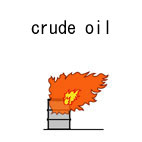| Case Name |
Fire of hydrogen sulfide that leaked from overflash piping of an atmospheric distillation column |
| Pictograph |

|
| Date |
February 16, 2000 |
| Place |
Kawasaki, Kanagawa, Japan |
| Location |
Refinery |
| Overview |
Fire occurred near overflash piping of the atmospheric distillation column. It was due to corrosion by hydrogen sulfide in the piping. It is necessary to check piping materials, standardize the exchange cycle of the piping, and prepare manuals including the above. Selection of the correct material is vital. |
| Incident |
A fire occurred near the overflash piping of an atmospheric distillation column. Refer to Fig2.
The atmospheric distillation column (topper) in an oil refinery is a large distillation column used after removing salt and moisture from crude oil, and is a major part of the atmospheric distillation unit (ADU), which separates crude oil into various fractions from gasoline to heavy oil. The overflash piping recovers a heavy gas oil fraction by extracting liquid from the upper point of the feed tray in the atmospheric distillation column, and returns it to the lower point of the feed tray after separating dissolved gas. The unit started operation in 1960, and this piping was installed in 1979. |
| Processing |
Manufacture |
| Individual Process |
Distillation |
| Substance |
Crude oil |
| Type of Accident |
Leakage, fire |
| Sequence |
An employee on patrol found the fire near the atmospheric distillation column during usual operation. There were no records of abnormal temperature or pressure in the operation diary. Although the inspection records of the piping did not show a clear indication of corrosion, records three years before the accident indicated that a tendency of corrosion was evident downstream from the orifice at near the center of horizontal piping. |
| Cause |
A part of the sulfur that could not be removed in the process before the atmospheric distillation column turned into hydrogen sulfide in the heating furnace. A slow flow velocity at the U-figured piping partially separated hydrogen sulfide which stayed in the upper part of the U-figured piping section. It is assumed that the free hydrogen sulfide at a high temperature of 350°C corroded the piping area, and the hydrogen sulfide that leaked from the opening ignited. |
| Response |
Extinguishing with water.
Stopping the use of overflash piping until next turnaround shutdown maintenance is completed. |
| Countermeasures |
Review of piping materials and shortening the piping exchange cycle. |
| Knowledge Comment |
The life of piping of a plant widely differs depending on its service conditions and flowing material. Selecting the correct structure and material is vital. |
| Background |
The progress of corrosion was unexpectedly rapid in the presence of hydrogen sulfide. The orifice plate set in the horizontal part of U-figured piping caused separation and accumulation of hydrogen sulfide, and a vapor phase was generated in the piping. The high temperature of 350°C accelerated corrosion. The atmospheric distillation unit is the most basic unit of a refinery and is used all over the world. Among the causes of the progress of corrosion, the special features of this particular unit should be considered. |
| Incidental Discussion |
Points with a high probability of corrosion were not fully studied before the accident. The event shows how important a prior study is when installing a new plant as well as remodeling. |
| Reason for Adding to DB |
Example of accident showing the importance of plant maintenance |
| Scenario |
| Primary Scenario
|
Insufficient Analysis or Research, Insufficient Prior Research, Dry Corrosion by Small Quantity Impurities, Poor Value Perception, Poor Safety Awareness, Inadequate Risk Recognition, Planning and Design, Poor Planning, Material Selection, Usage, Operation/Use, Operation at High Temperature/Dry, Failure, Abrasion, High Temperature Corrosion, Secondary Damage, External Damage, Fire
|
|
| Sources |
Kawasaki City Fire fighting station Prevention division, Peace section. Fire at overflash piping. Material of the Kawasaki City Complex safety countermeasure committee. (2000)
|
| Physical Damage |
The sheet metal for heat insulation was partially damaged by fire. About 100 liters of oil at the bottom of the column burned. |
| Financial Cost |
¥ 200,000 (Material of the Kawasaki City Complex safety countermeasure committee) |
| Multimedia Files |
Fig2.Sketch of the accident pipe
|
| Field |
Chemicals and Plants
|
| Author |
WAKAKURA, Masahide (Kanagawa Industrial Technology Research Institute)
TAMURA, Masamitsu (Center for Risk Management and Safety Sciences, Yokohama National University)
|